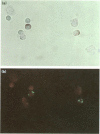Abstract
Mast cells (MC), blood basophils (Ba) and monocytes (Mo) are of haemopoietic origin. Lineage-relationships and transdifferentiation between MC and Mo, or MC and Ba, have been considered, based on common expression of antigens. In this study, comparative phenotypic analyses on MC, Ba and Mo and on respective cell lines were performed using monoclonal antibodies (mAb) to previously defined and novel CD antigens (CD1-130). By cluster analysis, the overall (all 130 CD) phenotypic relationships (given as similarity indices, SI), between primary cells (MC, Ba and Mo) and corresponding cell lines (HMC-1, KU-812, U937) were 0.716, 0.779 and 0.757, respectively. When primary cells were compared, lower SI values were found (MC versus Ba, 0.509; MC versus Mo, 0.625; Mo versus Ba, 0.698). More distant relationships were found between MC versus Ba and MC versus Mo, compared with Ba versus Mo, for adhesion receptor (R)-, complement R- and cytokine R profiles. Analysis of cytokine R revealed most significant dissimilarities between MC versus Ba and MC versus Mo (SI < 0.2). Moreover, in contrast to other CD subgroups and other lineages, MC and HMC-1 differed from each other in cytokine R expression (SI = 0.286). Cytokine R detectable on HMC-1 but not MC were granulocyte-macrophage colony-stimulating factor (GM-CSFR)alpha(CD116), CD40, Apo-1/FAS(CD95) and gp130(CD130). Cytokine R detectable on Ba but not MC, were interleukin-3 (IL-3)R alpha(CD123), IL-1RII(CD121b), IL-2R alpha(CD25) and CD40. In summary, MC, Ba and Mo display a unique CD profile with MC being the most distantly related cell. The most significant mismatch within a given lineage is the loss of cytokine R on mature MC as compared with normal myeloid progenitors and HMC-1 cells.
Full text
PDF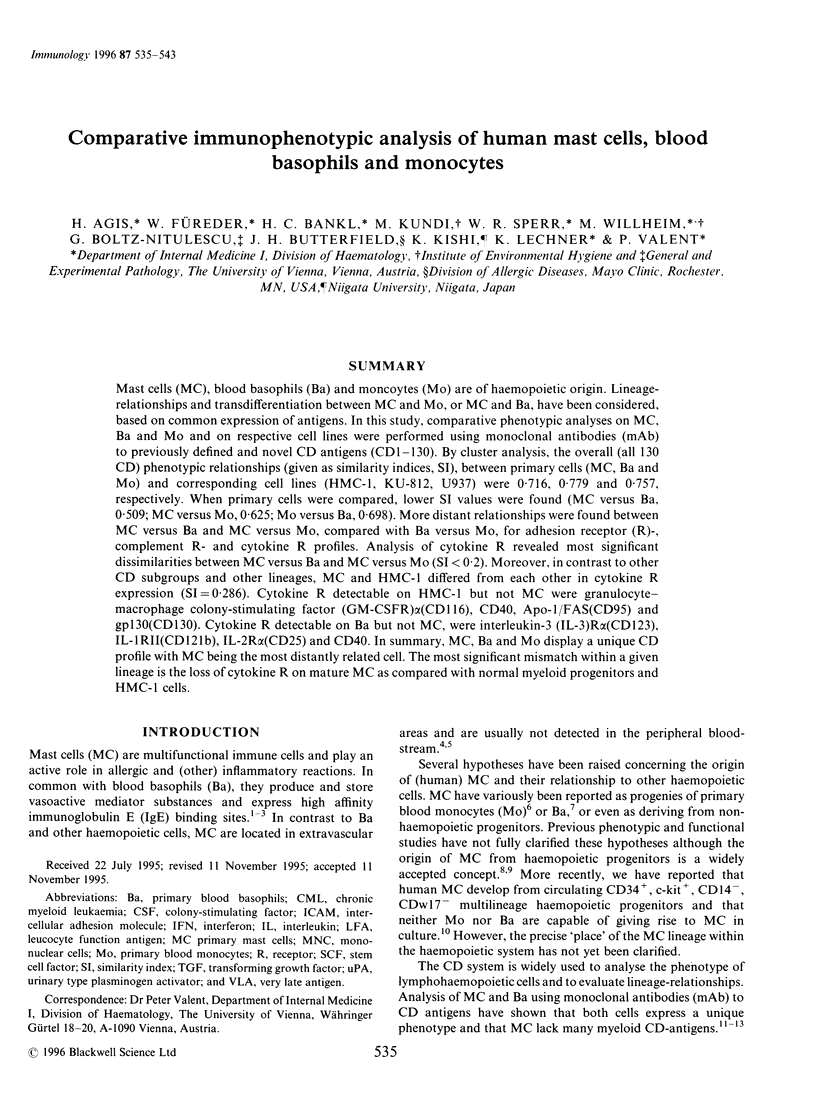

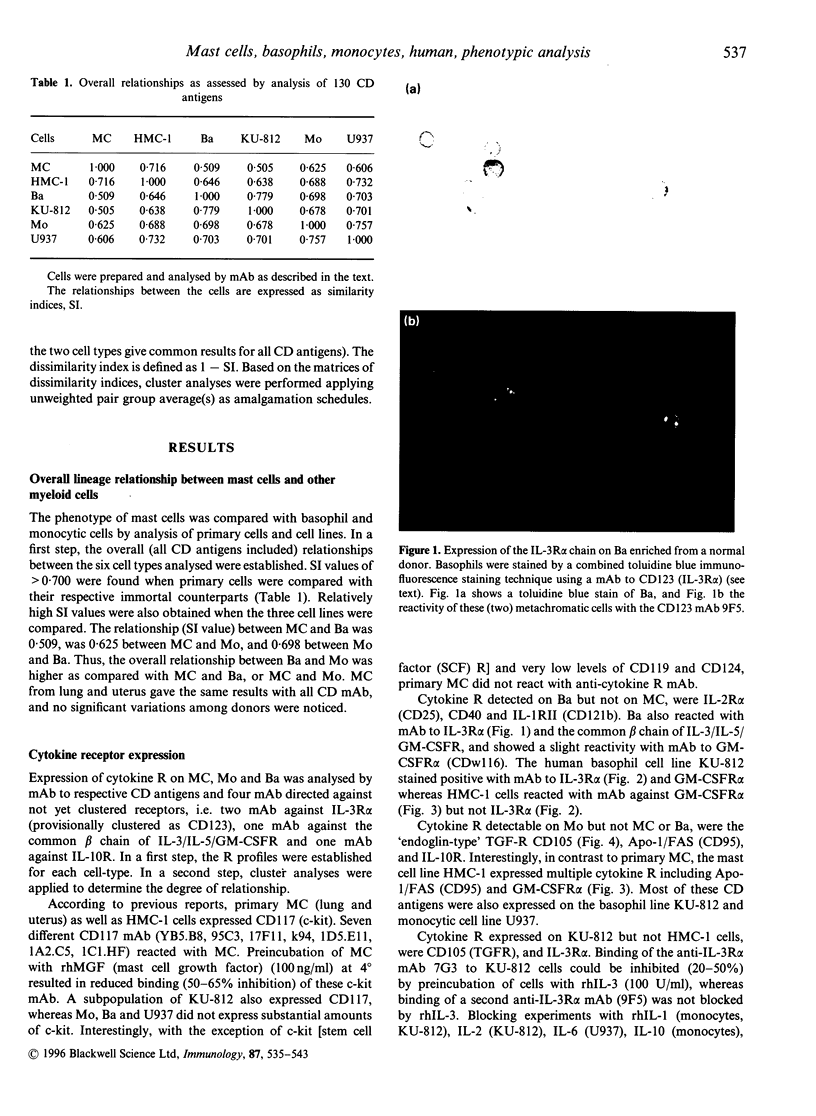
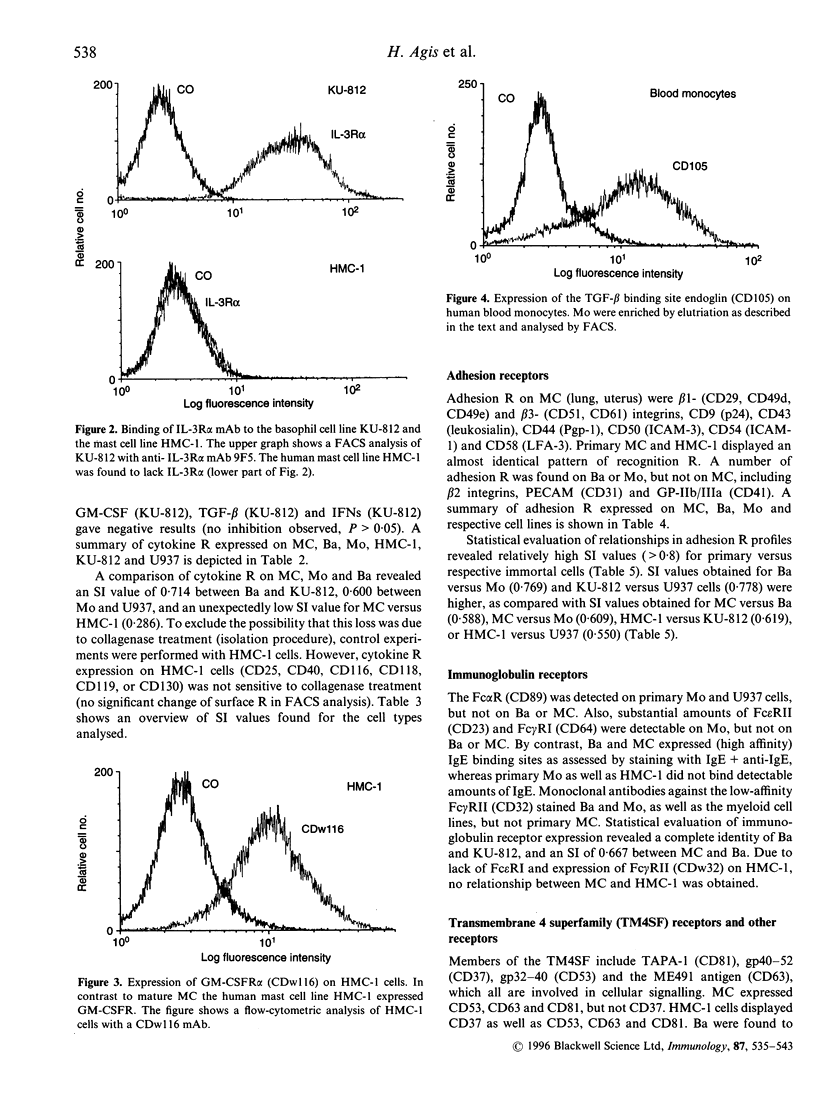
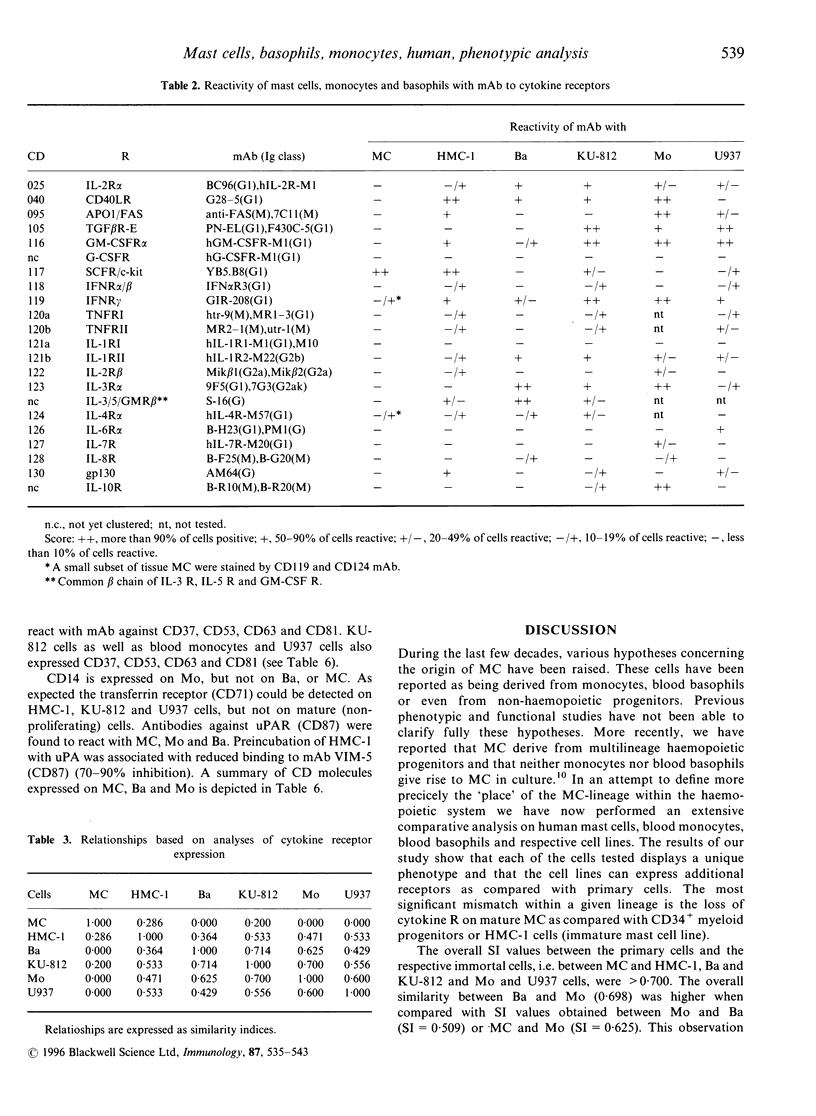
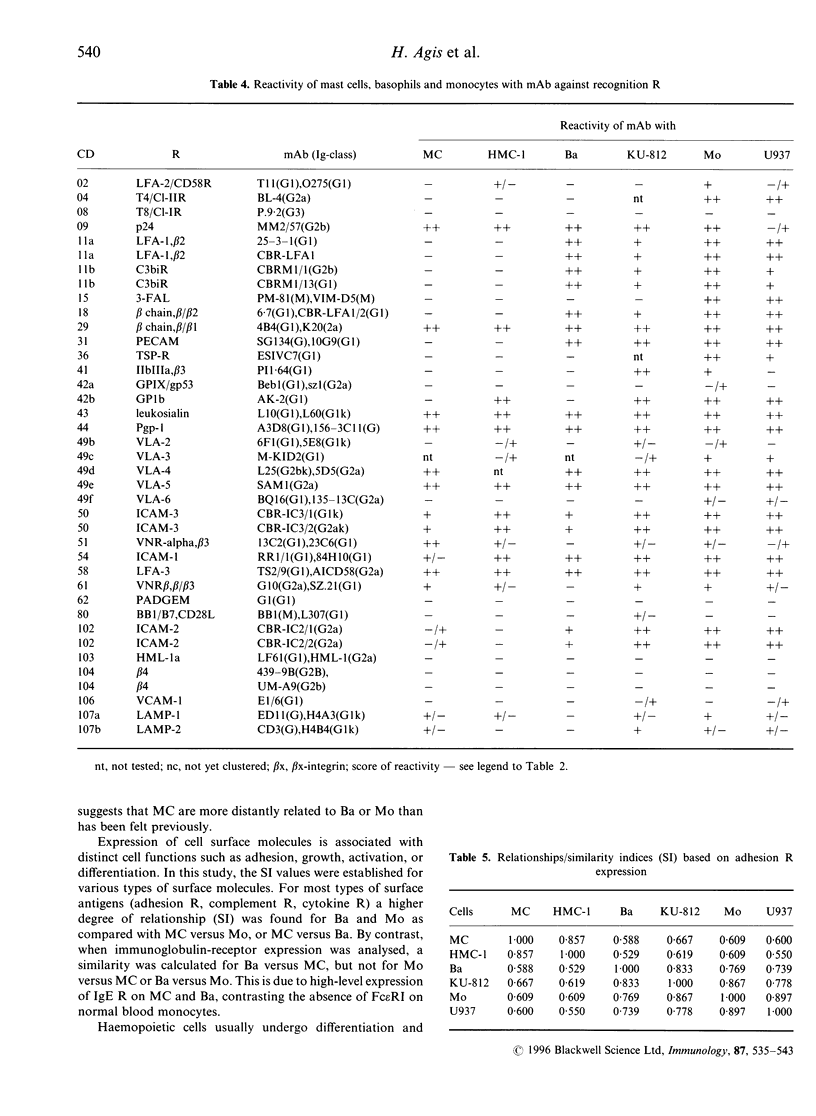
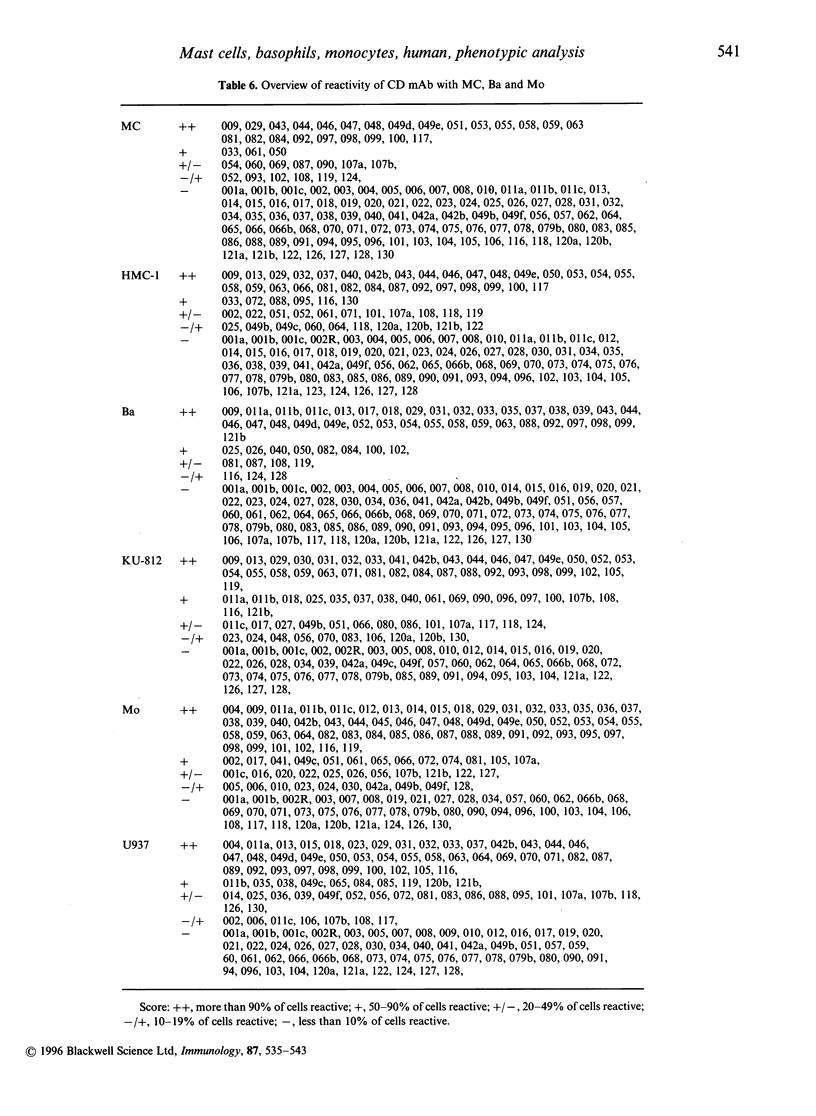
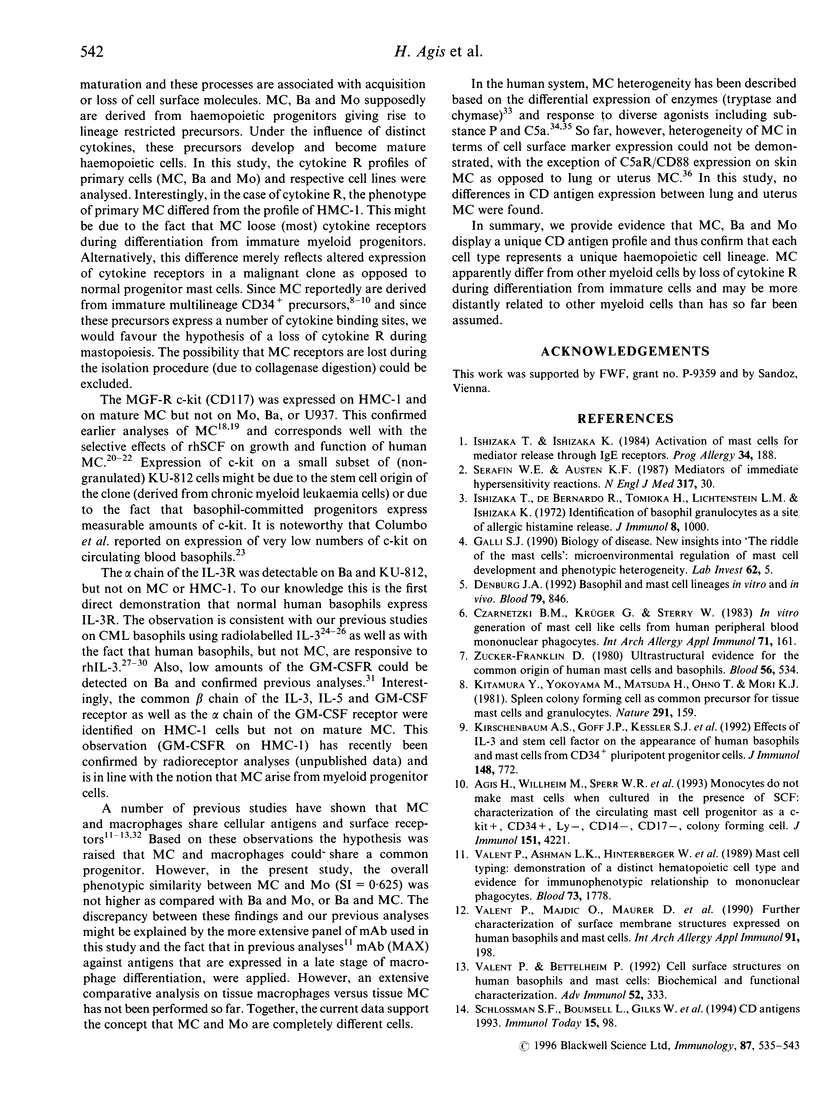
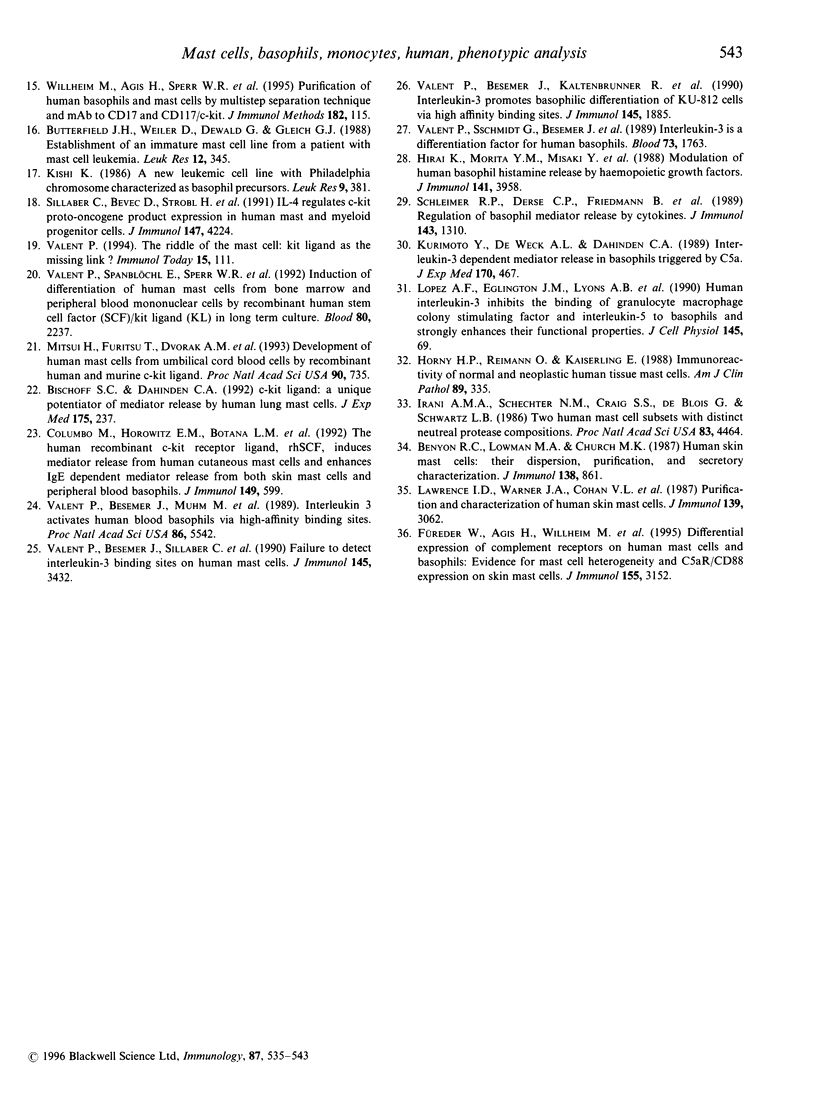
Images in this article
Selected References
These references are in PubMed. This may not be the complete list of references from this article.
- Agis H., Willheim M., Sperr W. R., Wilfing A., Krömer E., Kabrna E., Spanblöchl E., Strobl H., Geissler K., Spittler A. Monocytes do not make mast cells when cultured in the presence of SCF. Characterization of the circulating mast cell progenitor as a c-kit+, CD34+, Ly-, CD14-, CD17-, colony-forming cell. J Immunol. 1993 Oct 15;151(8):4221–4227. [PubMed] [Google Scholar]
- Benyon R. C., Lowman M. A., Church M. K. Human skin mast cells: their dispersion, purification, and secretory characterization. J Immunol. 1987 Feb 1;138(3):861–867. [PubMed] [Google Scholar]
- Bischoff S. C., Dahinden C. A. c-kit ligand: a unique potentiator of mediator release by human lung mast cells. J Exp Med. 1992 Jan 1;175(1):237–244. doi: 10.1084/jem.175.1.237. [DOI] [PMC free article] [PubMed] [Google Scholar]
- Butterfield J. H., Weiler D., Dewald G., Gleich G. J. Establishment of an immature mast cell line from a patient with mast cell leukemia. Leuk Res. 1988;12(4):345–355. doi: 10.1016/0145-2126(88)90050-1. [DOI] [PubMed] [Google Scholar]
- Columbo M., Horowitz E. M., Botana L. M., MacGlashan D. W., Jr, Bochner B. S., Gillis S., Zsebo K. M., Galli S. J., Lichtenstein L. M. The human recombinant c-kit receptor ligand, rhSCF, induces mediator release from human cutaneous mast cells and enhances IgE-dependent mediator release from both skin mast cells and peripheral blood basophils. J Immunol. 1992 Jul 15;149(2):599–608. [PubMed] [Google Scholar]
- Czarnetzki B. M., Krüger G., Sterry W. In vitro generation of mast cell-like cells from human peripheral mononuclear phagocytes. Int Arch Allergy Appl Immunol. 1983;71(2):161–167. doi: 10.1159/000233381. [DOI] [PubMed] [Google Scholar]
- Denburg J. A. Basophil and mast cell lineages in vitro and in vivo. Blood. 1992 Feb 15;79(4):846–860. [PubMed] [Google Scholar]
- Füreder W., Agis H., Willheim M., Bankl H. C., Maier U., Kishi K., Müller M. R., Czerwenka K., Radaszkiewicz T., Butterfield J. H. Differential expression of complement receptors on human basophils and mast cells. Evidence for mast cell heterogeneity and CD88/C5aR expression on skin mast cells. J Immunol. 1995 Sep 15;155(6):3152–3160. [PubMed] [Google Scholar]
- Galli S. J. New insights into "the riddle of the mast cells": microenvironmental regulation of mast cell development and phenotypic heterogeneity. Lab Invest. 1990 Jan;62(1):5–33. [PubMed] [Google Scholar]
- Hirai K., Morita Y., Misaki Y., Ohta K., Takaishi T., Suzuki S., Motoyoshi K., Miyamoto T. Modulation of human basophil histamine release by hemopoietic growth factors. J Immunol. 1988 Dec 1;141(11):3958–3964. [PubMed] [Google Scholar]
- Horny H. P., Reimann O., Kaiserling E. Immunoreactivity of normal and neoplastic human tissue mast cells. Am J Clin Pathol. 1988 Mar;89(3):335–340. doi: 10.1093/ajcp/89.3.335. [DOI] [PubMed] [Google Scholar]
- Irani A. A., Schechter N. M., Craig S. S., DeBlois G., Schwartz L. B. Two types of human mast cells that have distinct neutral protease compositions. Proc Natl Acad Sci U S A. 1986 Jun;83(12):4464–4468. doi: 10.1073/pnas.83.12.4464. [DOI] [PMC free article] [PubMed] [Google Scholar]
- Ishizaka T., De Bernardo R., Tomioka H., Lichtenstein L. M., Ishizaka K. Identification of basophil granulocytes as a site of allergic histamine release. J Immunol. 1972 Apr;108(4):1000–1008. [PubMed] [Google Scholar]
- Ishizaka T., Ishizaka K. Activation of mast cells for mediator release through IgE receptors. Prog Allergy. 1984;34:188–235. [PubMed] [Google Scholar]
- Kirshenbaum A. S., Goff J. P., Kessler S. W., Mican J. M., Zsebo K. M., Metcalfe D. D. Effect of IL-3 and stem cell factor on the appearance of human basophils and mast cells from CD34+ pluripotent progenitor cells. J Immunol. 1992 Feb 1;148(3):772–777. [PubMed] [Google Scholar]
- Kishi K. A new leukemia cell line with Philadelphia chromosome characterized as basophil precursors. Leuk Res. 1985;9(3):381–390. doi: 10.1016/0145-2126(85)90060-8. [DOI] [PubMed] [Google Scholar]
- Kitamura Y., Yokoyama M., Matsuda H., Ohno T., Mori K. J. Spleen colony-forming cell as common precursor for tissue mast cells and granulocytes. Nature. 1981 May 14;291(5811):159–160. doi: 10.1038/291159a0. [DOI] [PubMed] [Google Scholar]
- Kurimoto Y., de Weck A. L., Dahinden C. A. Interleukin 3-dependent mediator release in basophils triggered by C5a. J Exp Med. 1989 Aug 1;170(2):467–479. doi: 10.1084/jem.170.2.467. [DOI] [PMC free article] [PubMed] [Google Scholar]
- Lawrence I. D., Warner J. A., Cohan V. L., Hubbard W. C., Kagey-Sobotka A., Lichtenstein L. M. Purification and characterization of human skin mast cells. Evidence for human mast cell heterogeneity. J Immunol. 1987 Nov 1;139(9):3062–3069. [PubMed] [Google Scholar]
- Lopez A. F., Eglinton J. M., Lyons A. B., Tapley P. M., To L. B., Park L. S., Clark S. C., Vadas M. A. Human interleukin-3 inhibits the binding of granulocyte-macrophage colony-stimulating factor and interleukin-5 to basophils and strongly enhances their functional activity. J Cell Physiol. 1990 Oct;145(1):69–77. doi: 10.1002/jcp.1041450111. [DOI] [PubMed] [Google Scholar]
- Mitsui H., Furitsu T., Dvorak A. M., Irani A. M., Schwartz L. B., Inagaki N., Takei M., Ishizaka K., Zsebo K. M., Gillis S. Development of human mast cells from umbilical cord blood cells by recombinant human and murine c-kit ligand. Proc Natl Acad Sci U S A. 1993 Jan 15;90(2):735–739. doi: 10.1073/pnas.90.2.735. [DOI] [PMC free article] [PubMed] [Google Scholar]
- Schleimer R. P., Derse C. P., Friedman B., Gillis S., Plaut M., Lichtenstein L. M., MacGlashan D. W., Jr Regulation of human basophil mediator release by cytokines. I. Interaction with antiinflammatory steroids. J Immunol. 1989 Aug 15;143(4):1310–1317. [PubMed] [Google Scholar]
- Schlossman S. F., Boumsell L., Gilks W., Harlan J. M., Kishimoto T., Morimoto C., Ritz J., Shaw S., Silverstein R. L., Springer T. A. CD antigens 1993. Immunol Today. 1994 Mar;15(3):98–99. doi: 10.1016/0167-5699(94)90149-X. [DOI] [PubMed] [Google Scholar]
- Serafin W. E., Austen K. F. Mediators of immediate hypersensitivity reactions. N Engl J Med. 1987 Jul 2;317(1):30–34. doi: 10.1056/NEJM198707023170106. [DOI] [PubMed] [Google Scholar]
- Sillaber C., Strobl H., Bevec D., Ashman L. K., Butterfield J. H., Lechner K., Maurer D., Bettelheim P., Valent P. IL-4 regulates c-kit proto-oncogene product expression in human mast and myeloid progenitor cells. J Immunol. 1991 Dec 15;147(12):4224–4228. [PubMed] [Google Scholar]
- Valent P., Ashman L. K., Hinterberger W., Eckersberger F., Majdic O., Lechner K., Bettelheim P. Mast cell typing: demonstration of a distinct hematopoietic cell type and evidence for immunophenotypic relationship to mononuclear phagocytes. Blood. 1989 May 15;73(7):1778–1785. [PubMed] [Google Scholar]
- Valent P., Besemer J., Kishi K., Kaltenbrunner R., Kuhn B., Maurer D., Lechner K., Bettelheim P. IL-3 promotes basophilic differentiation of KU812 cells through high affinity binding sites. J Immunol. 1990 Sep 15;145(6):1885–1889. [PubMed] [Google Scholar]
- Valent P., Besemer J., Muhm M., Majdic O., Lechner K., Bettelheim P. Interleukin 3 activates human blood basophils via high-affinity binding sites. Proc Natl Acad Sci U S A. 1989 Jul;86(14):5542–5546. doi: 10.1073/pnas.86.14.5542. [DOI] [PMC free article] [PubMed] [Google Scholar]
- Valent P., Besemer J., Sillaber C., Butterfield J. H., Eher R., Majdic O., Kishi K., Klepetko W., Eckersberger F., Lechner K. Failure to detect IL-3-binding sites on human mast cells. J Immunol. 1990 Nov 15;145(10):3432–3437. [PubMed] [Google Scholar]
- Valent P., Bettelheim P. Cell surface structures on human basophils and mast cells: biochemical and functional characterization. Adv Immunol. 1992;52:333–423. doi: 10.1016/s0065-2776(08)60879-2. [DOI] [PubMed] [Google Scholar]
- Valent P., Majdic O., Maurer D., Bodger M., Muhm M., Bettelheim P. Further characterization of surface membrane structures expressed on human basophils and mast cells. Int Arch Allergy Appl Immunol. 1990;91(2):198–203. doi: 10.1159/000235115. [DOI] [PubMed] [Google Scholar]
- Valent P., Schmidt G., Besemer J., Mayer P., Zenke G., Liehl E., Hinterberger W., Lechner K., Maurer D., Bettelheim P. Interleukin-3 is a differentiation factor for human basophils. Blood. 1989 May 15;73(7):1763–1769. [PubMed] [Google Scholar]
- Valent P., Spanblöchl E., Sperr W. R., Sillaber C., Zsebo K. M., Agis H., Strobl H., Geissler K., Bettelheim P., Lechner K. Induction of differentiation of human mast cells from bone marrow and peripheral blood mononuclear cells by recombinant human stem cell factor/kit-ligand in long-term culture. Blood. 1992 Nov 1;80(9):2237–2245. [PubMed] [Google Scholar]
- Valent P. The riddle of the mast cell: kit(CD117)-ligand as the missing link? Immunol Today. 1994 Mar;15(3):111–114. doi: 10.1016/0167-5699(94)90153-8. [DOI] [PubMed] [Google Scholar]
- Willheim M., Agis H., Sperr W. R., Köller M., Bankl H. C., Kiener H., Fritsch G., Füreder W., Spittler A., Graninger W. Purification of human basophils and mast cells by multistep separation technique and mAb to CDw17 and CD117/c-kit. J Immunol Methods. 1995 May 11;182(1):115–129. doi: 10.1016/0022-1759(95)00034-8. [DOI] [PubMed] [Google Scholar]
- Zucker-Franklin D. Ultrastructural evidence for the common origin of human mast cells and basophils. Blood. 1980 Sep;56(3):534–540. [PubMed] [Google Scholar]



